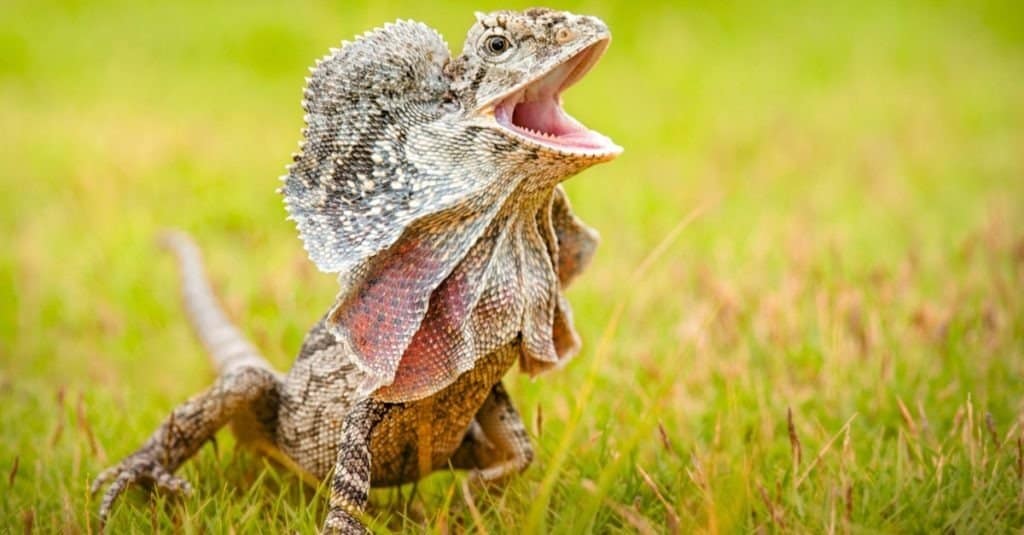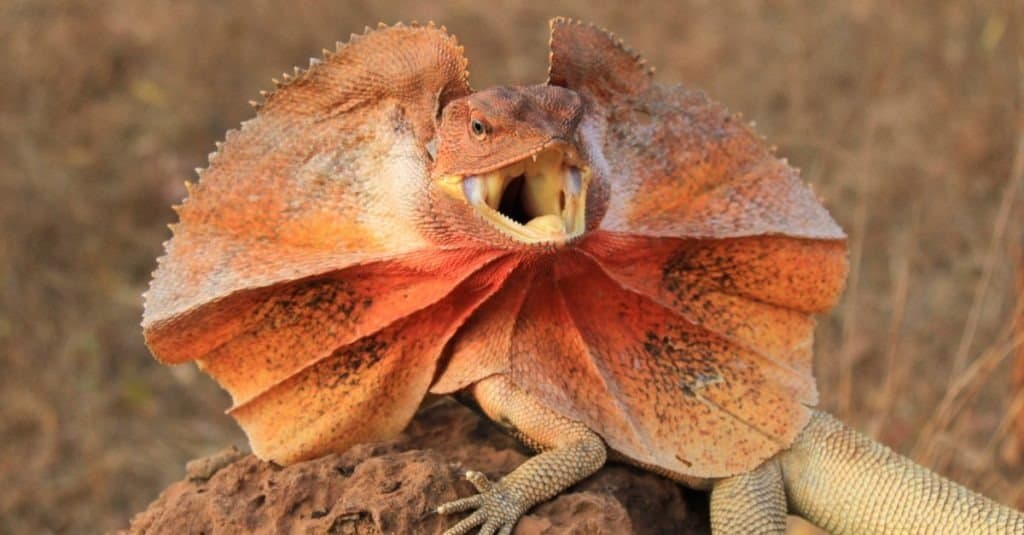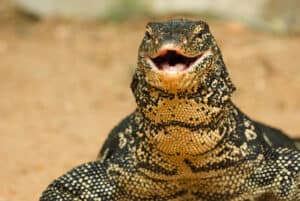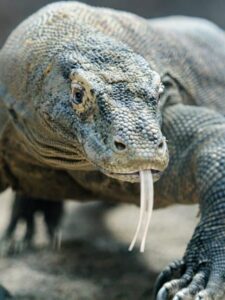Have you ever seen a frilled lizard? If you have, you’re probably wondering why they look like something straight out of Jurassic Park! What even is a frilled lizard, anyway, and what purpose does its massive neck frill serve? Where do these strange reptiles come from? What do they eat? Is it possible to keep them as pets?
Let’s take an in-depth look at this unusual lizard and why it’s so fascinating.
What is a Frilled Lizard?

Frilled lizards use their neck frills as a clever defense mechanism!
©Matt Cornish/Shutterstock.com
Frilled lizards, also known as frill-necked lizards or frilled dragons, are medium-sized agamid lizards in the Agamidae family. Agamids are also known as “dragon lizards,” and the group includes species like the bearded dragon and the Chinese water dragon. More specifically, frilled lizards are the sole members of the Chlamydosaurus genus.
The frilled lizard’s common name, of course, comes from the large frill of skin around its neck! However, while you’ve probably only seen pictures or videos of this unique species with its frill extended, the flap of skin typically rests flat up against its neck. The lizard mainly uses its frill as a defense mechanism. When extended, the frill makes the lizard look more intimidating, ideally to startle and ward off predators.
These strange-looking lizards are fairly large as far as agamid lizards go, reaching up to around 2.5 feet long as adults! Their bodies are long and lean, and they sometimes will rear up on their hind limbs and sprint short distances. The lizard’s tail makes up a large portion of its total body length. There is some debate over its exact lifespan in the wild, but in captivity, they commonly live for 15 to 20 years or more.
As they are native to mostly arid, desert environments in Australia, their coloration typically closely matches their surroundings. Most frilled lizards are a mottled brown, grey, tan, or even reddish-orange color depending on where they live, giving them subtle camouflage.
Today, frilled lizards are slowly becoming more popular in the pet trade. However, they can be fairly expensive and difficult to find, as they aren’t very commonly bred in captivity.
Where Do Frilled Lizards Live?

Frill-necked lizards mostly live along Australia’s northern coastline.
©Hadrani Hasan/Shutterstock.com
Frilled lizards are native to Australia’s northwestern coast. This coastline borders the Indian Ocean, the Arafura Sea, and the Coral Sea to the northwest, north, and northeast, respectively. The frilled lizard’s habitat is fairly humid, and the species is highly arboreal, living amongst the trees in temperate forests and tropical woodlands.
Famous British zoologist John Edward Gray originally discovered and taxonomically defined frilled lizards in 1825. Gray worked heavily in the field of taxonomy and described more than 300 unique species, mostly reptiles and marine snails. The first frilled lizard he defined and studied was collected during an expedition near Australia’s northwestern coast. This coastal area, as mentioned above, is the frilled lizard’s primary native habitat even today.
As frilled lizards are highly arboreal, they spend most of their time high up in the trees. The dense foliage of their habitat makes it easy for them to camouflage themselves when hiding from predators. Occasionally, they will descend from the trees to search for insects and other small animals to feed on, like termites, spiders, and cicadas.
When it comes time to reproduce, frilled lizards will also come down from the trees to lay their eggs. They dig underground burrows in the sand, dirt, and leaf litter to safely house their eggs, laying clutches of around 10 to 20 eggs at a time.
Why Do Frilled Lizards Have Frills?

When not extended, the frill-necked lizard’s frill rests almost flat against the lizard’s neck.
©Susan Schmitz/Shutterstock.com
The frilled lizard primarily uses its neck frill to startle and scare off predators. The neck frill is essentially a loose flap of skin with long, thin rods of cartilage throughout that function as supports. These cartilage rods are connected to the lizard’s jaw.
When threatened, a frilled lizard will typically open its mouth wide and fully extend its frill. Sometimes, the lizard will also rear up on its hind legs and lift its tail in the air to make itself look even larger.
While this strange reptile’s neck frill looks like nothing more than a fashionable accessory, it actually serves an important purpose! The lizard uses its frill in what is known as a deimatic display, or startle display, to scare off predators.
Various types of animals have adaptations they use in deimatic displays! From butterflies with creepy-looking eyespots that mimic snakes’ eyes to octopuses’ bright color displays, deimatic behaviors can be extremely useful for survival.

The frilled-neck dinosaur in Jurassic Park was fictionalized and based on the frilled lizards of today.
©Cheng Wei/Shutterstock.com
While frilled lizards look like the dinosaurs from Jurassic Park, the two couldn’t be more different. The frill-necked dinos in Jurassic Park, Dilophosaurus, were highly fictionalized. In fact, real-life Dilophosaurs likely didn’t even have neck frills, nor were they venomous! The film’s writers were certainly inspired by the frilled lizard when bringing the Dilophosaurus to life, though.
What Do Frilled Lizards Eat?

Frilled lizards often sit atop termite mounds, lapping up the little bugs as they emerge.
©Matt Cornish/Shutterstock.com
Frilled lizards are omnivorous, though they mostly feed on small insects. However, they are fairly opportunistic in the wild. If they can’t find their usual fare and become desperate, they will also occasionally feed on larger prey like rodents and even other, smaller lizards.
Some of the most common foods frilled lizards eat include the following:
In the wild, frill-necked lizards primarily hunt by camouflaging themselves amongst the trees, waiting silently for an insect or other small animal to wander past. When a prey animal comes close enough, the frilled lizard will take the opportunity to strike. Their coloration helps them blend in better with tree bark and foliage–not only to hide from predators, but also to better hunt prey.
In captivity, frilled lizards should primarily eat insects and arthropods. Feeder insects like dubia roaches, crickets, and hornworms are all excellent options for a pet frilled lizard’s diet. Some individuals will also eat vegetation, but this is rare and usually only happens if their other food sources are especially scarce.
The photo featured at the top of this post is © Ken Griffiths/Shutterstock.com
Thank you for reading! Have some feedback for us? Contact the AZ Animals editorial team.






